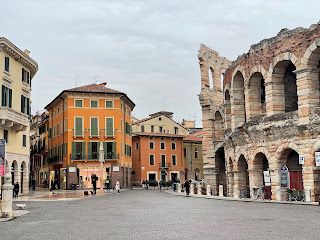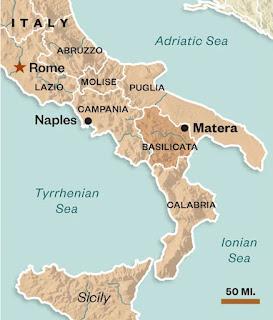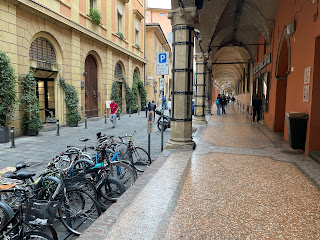Verona - the City of Love
Mostly known for its connection to Shakespeare's Romeo and Juliet, Verona is also packed with historic charm, ancient Roman ruins, a medieval fortress, piazzas and river views. We took the train there for a day trip, bought the 24-hour Verona pass, and soaked up the City of Love.
Greg is always looking out for me when we travel, making sure I am aware that there are cars around me. Awww, to be in love. He is so romantic, right? "You don't want me to get smashed by a bus?""No, I want to get back," he quickly admits, directionally challenged and knowing he could be lost in Verona possibly forever without me. I guess I should be thankful that after 29 years of marriage he isn't pushing me in front of a bus!
Our first stop was the massive Roman amphitheater - the Arena di Verona in the Piazza Bra
Built outside the original city walls, the Arena di Verona is one of the first sites you reach from the train station. At 2,000 years old, it is one of the best-preserved ancient Roman structures in the world. The third largest arena in Italy, it has a past similar to the Coliseum in Rome: brutal gladiatorial games, jousts, circuses, and tournaments, centuries filled with garbage, disassembled to repurpose the large building stones, etc. Today only two of the original three tiers of arches have survived.
In 1117, a tremendous earthquake destroyed the Arena's outer wall except for a section of four arches (the wing) that has become its principal identifying feature and can be seen from high points throughout the city.
Coming out onto the stand, you immediately are inspired by the greatness of the Arena and the genius of Roman architecture.
Nowadays, the amphitheater is used all summer for concerts, ballets, and opera performances. Now they are busy removing the temporary seats and stage; we were warned at the entrance that arena access is greatly reduced. With so many passageways blocked off, getting around the arena was like figuring out a maze… it was a puzzle as we repeatedly reached dead ends.
Normally as one of the city's key sites, the arena has long lines to get in, but not today - and we were the first to walk right in. You can buy your 24-hour Verona pass at the tourist center in the piazza to skip the arena line, or buy it at the arenas's ticket window like we did. There is no point in buying it online because you then have to pick it up at the tourist center. We found the pass to be totally convenient and worth it, as most visitors will quickly at least break even.
Leaving the arena and huge Piazza Bra, we walked down the pedestrian-only Via Mazzini to Piazza delle Erbe, Verona's most picturesque square. I'd say don't miss it, but it is on the way to the majority of Verona's other sites so there's no way you can come here and not at least walk through it. Laying above what was formerly the Roman Forum, it is the city's oldest square. Today it is a market selling fruit and souvenirs.
In Piazza delle Erbe, look for Madonna Verona fountain (the Lady of Verona, not Jesus' mother) who has been proudly capturing time (and pigeons) here since 1368. She is actually an ancient and repurposed Roman statue. Don't miss the famous Case Mazzanti: among the oldest buildings in Verona, they still preserve the 16th-century frescoes on the facade, from a time when Verona's prominent families decorated their palaces to show prestige without spending a fortune.
Standing tall in the piazza is the Lamberti Tower and of course we weren't going to pass up an opportunity to climb it!
Even though it was already 10am, there was no line when it opened and we had it completely to ourselves for 15 minutes.
Climb the Lamberti Tower for great panoramic views over the city's red rooftops of Verona.
With reserved roundtrip train tickets allocating an entire day in the unusually quiet city of Verona, we had ample time to spare and throw in extra, unplanned sightseeing (that was included in our Verona Day Pass). So while visiting the Castel Vecchio Bridge, we also went into its attached fortress: Castel Vecchio. The political instability of Verona during the middle ages led the della Scala family to greatly contribute to the development of Verona. They built Castel Vecchio to protect themselves from the Veronese people as much as invading outsiders. It is now a museum - and another maze with lots of dead ends.
The Ponte di Castelvecchio, or Skaliger Bridge, was built in 1354
The center of the bridge thrusts out in both directions with ramparts that you can climb for a better view
"In fair Verona, where we lay our scene...", writes William Shakespeare in the opening lines of Romeo and Juliet, forever linking Verona to tales of love, tragedy, and timeless romance. I'm by no means a die-hard Juliet fan but when in Verona it would make absolutely no sense to skip a visit to her house, especially considering you can see it's highlights for free. Just remember: Juliet is a made-up character and Shakespeare probably never visited this house (or even Verona). With time to kill, we went into her house (included in the Verona Pass). Make sure you make a reservation! Since there were no crowds, for us arriving and making our reservation meant instant access. If you don't want to step onto the balcony just for kicks, then don't even bother to go into the house.
The balcony, where Juliet used to wait for her beloved Romeo every night
Touching Juliet's breast brings good fortune in love
You can lock your love here (they sell them in the store) or leave graffiti along all the walls and bricks - or even leave a love letter and get a response
Feeling an occasional drop of rain and knowing there would be no worthy sunset, we moved up our last itinerary item - and walked up to Piazzale Castel San Pietro for the best panoramic views over city. Ponte Pietra - the bridge you cross to get to Piazzale Castel San Pietro - dates back to the 1st century BC, and is the oldest bridge in Verona. As they hastily left Verona at the end of WWII, the German troops blew up all of Verona's bridges to slow the Allied Army's pursuit.
Ponte Pietra - of the ancient Roman bridge only part of the left arch was saved.
The Castel San Pietro sits at the top of the hill and is walkable or accessible by a funicular for €2.
From the top of the hill, you can capture one of the most picturesque views of the city. The castle (actually Austrian barracks from 1854 and not a castle) is not open to the public.
I was so tired when we got to Basilica of Santa Anastasia (near Ponte Pietra) that we sat down in the pews - and made jokes about praying for a while (with my eyes closed).
It started raining at 4pm which mean we had to sit in a bar for an hour until, our train. Had to.
This is what happens to Greg after he has been forced to sit in a bar.
After a walk to Verona's train station in the rain, we had dinner back in Bologna which doesn't warrant mention (despite its high reviews), then packed up for our 4:25am departure to southern Italy.




















Comments
Post a Comment